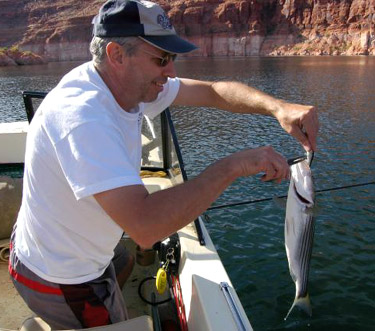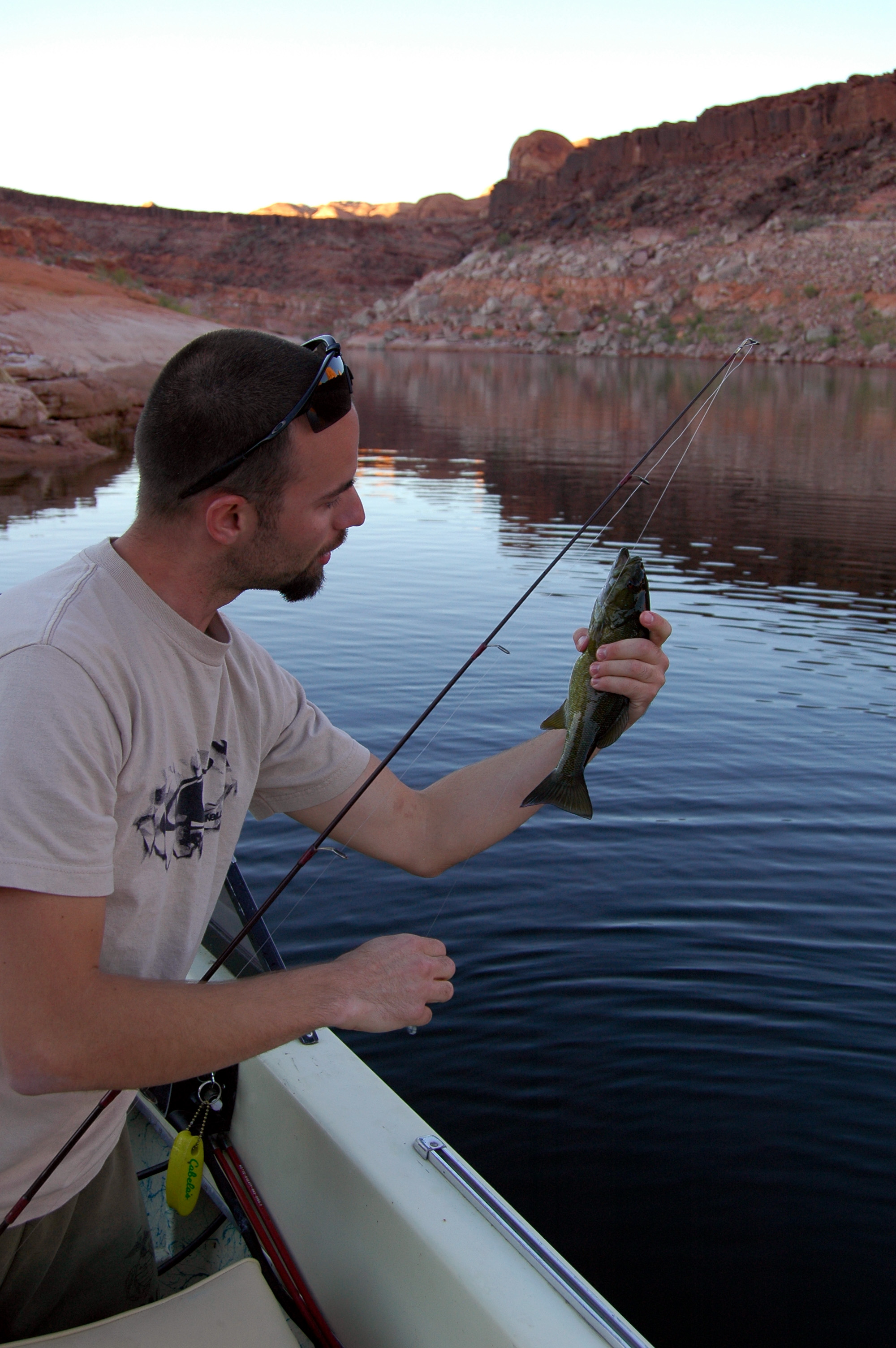
 By Aaron Webb
By Aaron Webb
We hit the big lake last week, my dad and I, looking for the fall season striper boils along the main channel. The weather was crisp and the water pretty chilly, at least for Lake Powell anyway. In the mountains, as we drove down to Bullfrog, the foliage on the trees had turned to bright shades of yellow and orange, though every here and there remained some green, and every here and there had appeared vibrant crimson.
The striped bass have been abnormally inactive this season, and most think that it is on account of the overwhelmingly healthy populations of their favorite meal-the threadfin shad. During inactive seasons, the stripers are lazy; there is so much food within their reach that they hardly have to go hunting for it. Thus, during inactive seasons, the stripers rarely boil.
For those of you that have never hit a striper boil, you are missing out on some of the most spectacular and exciting fishing you will ever encounter aside from fighting something larger than yourself on a deep-sea rig. The striped bass at Lake Powell are famous for their yearly boils, when the hungry fish go into feeding frenzies as they chase the schools of fattened shad, pouncing on unsuspecting schools like ravenous wolf packs. The shad, fat though they may be, are still extremely active as they try to evade the coordinated attack of the striped bass schools, often leaping into the air, or even onto the beach in order to get away. The bass themselves splash and leap, and a striper boil can make as much noise and boiling, frothy water as a rowdy group of beach-going teenagers.
This year though, it seemed as though the stripers were experiencing such plentiful food that they could wait for it to come to them. My theory is that the invading gizzard shad, capable of reproducing much faster and growing much larger than the stripers' staple threadfin, have broken the bust-and-boom cycle that has (more or less) worked for so long in the lake. Gizzard shad were introduced into Lake Powell a few years ago by accident, and are now replacing the threadfin shad as the dominant forage fish. Though their eventual role in the ecosystem of Lake Powell is not yet understood, they have so far been a cause for concern as they have intruded upon nearly all aspects of the life cycles of the lake's other denizens.
So, there have been few striper boils this year. This meant that the bass were getting fat and happy, and evading the hooks of the anglers to a large degree.
However, we had some top secret intel stating that they were going to be active this weekend, and that it might be the last chance this year to hit a striper boil. A striper boil in an of itself is a coveted event to be a part of, but to hit a striper boil made up of extraordinarily large, fat, and aggressive bass, well that was something I have yet to see in my years on the lake.
Our plan was to cruise the main channel from the Bullfrog marina, down to the San Juan arm, and then head east into those quiet, secluded canyons that so many people never see.
Even in the bright noonday sun, it was chilly, so long as we were moving. My dad's boat is not built for racing, but it can maintain a pretty decent speed across the calm, glassy surface of Lake Powell, and the subsequent wind had a crisp edge to it that left goose bumps on my arms and neck as we cruised south. When we would find a spot we wanted to fish, we'd stop and drift, or troll slowly, and then the unabated heat of the sun would feel like a smothering blanket, and we'd eventually reel in and get moving again.
No striper boils were anywhere to be seen. We saw an occasional, solitary jumper out there, but no crazed masses of bass, leaping voraciously out of the water after the silver-sided shad.
We reached the San Juan arm of Lake Powell with hardly a stop. Most boaters that come in from Bullfrog stay in the general vicinity. In fact, when my dad pointed out the houseboats that had merely gone to the far side of Bullfrog Bay to anchor and set camp, I could only stare in dumbfounded amazement.
Why would anyone go to Lake Powell to stick around at Bullfrog? Sure, the facilities there were great, but I go to Powell to escape the crowds, not to hang out with them. Even were they to travel just a few miles south of Bullfrog, boaters could find themselves in the quiet depths of a seldom-visited side canyon-especially as summer winds to a chilly close.
Then San Juan arm, farther south even than the Escalante, is nothing if not secluded. We saw three other boats there during our entire trip; everyone else was in the main channel. I haven't been to Powell for a few years now since I have been hopping from one state (or country) to the next since high school, and the last time I was at the lake, I had been devastated by the dramatic drop in water level. This year, as we turned into the mouth of the San Juan, I contemplated the healthier water level, and the slowly disappearing band of white along the canyon walls. Eventually, all of that will crumble away too, and only the beautiful red rock will remain, unscarred and unstained by the waterlines of past years.
By the time we entered the San Juan, the sun was dipping low, reflecting a radiant orange glow from the Lake Powell sandstone. We traveled up-canyon a few miles, and then turned into Wilson Creek Canyon. The air was chilly even when we stopped now, and I threw on my jacket and sweats as the clouds of bugs rose into the evening air. We killed the motor and drifted into a small, dark cove in the area, and started fishing.
Here, among the submerged rocks and weeds of the cove, we knew we wouldn't find any striped bass, but the smallmouth were supposed to be pretty plentiful this year as well, and we figured that we might capitalize on that fact. We both chose Rapalas for our weapon of choice, my dad with a smaller, minnow Rapala, and myself with the old, fat crawdad. No sooner had we silently floated into the cove, than we began to catch smallmouth bass. Most of them were on the small end of medium-sized, though a few of them were barely larger than the lures we were using to catch them, and one or two of them were decent, medium-sized fish.
All of them were plump and healthy, and apparently-judging by the number of fingerlings that we caught on large lures-fairly confident and gluttonous. By the time it was dark, we had stopped counting how many smallmouth bass we had caught, moving from one cove to the next, always looking for the hole in which lurked the larger, cannier fish. We had kept none of them, as they were still below the size of fish that we were looking for.
We made camp, ate a quick dinner, and went to bed. In the morning, we slept past dawn, missing some of the better fishing of the day, and had a late breakfast. Then we decided to explore the shoreline near our campsite, hiking through the dense mess of brush and rocks in order to find a few more shaded coves that might find us our larger fish. We had absolutely no luck from shore; the smallmouth would patrol right past us as we fished, watching us like curious schoolchildren on a field trip to the zoo-but none of them would bite. I had a few chase my hook, playing, a nibble here or there, but nothing substantial. I suppose that we were just too visible and obvious to them, standing on the shore like that. So, despite the fact that my little brain still doesn't understand how a 15-foot boat is less obvious in such small coves, we hiked back to camp, packed up, and headed deeper into the San Juan.
Again, we would troll up to a promising cove, kill the motor, and drift in, throwing out the shad-colored Rapala, and the crawdad, or a few other Rapala variants that we were testing. The silver-sided shad Rapala was the winner though, and nearly every cast from the boat landed a smallmouth bass of one size or another. We still weren't finding any large fish though. So we turned around after catching probably 30 smallmouth between the two of us, and began trolling out of the San Juan.
Heading between two coves, still a few miles up the San Juan arm, my dad hooked something big, large enough to provide a minute or two of serious battling as it kept swimming away, taking line, and fighting hard. I reeled my line in and waited with the camera as my dad brought this fighter in close enough to the surface that it leapt out of the water in an attempt to slip free of the hook; it was a striped bass. For the amount of fight in it, we had been expecting something larger; this one was only about 14 or 15 inches or so, but it was a mean one, and the largest fish that we'd caught this trip. It too was caught on the silver-colored Rapala. Disappointed that it was not one of a frenzying, boiling school, dad loosed it, and we made our way back into the main channel.
This was a new boat, and we were still a little unsure as to how far we could go with the fuel load that we had, so we decided to play it safe and return toward Bullfrog at that time. We cruised along at about 17 knots, making Bullfrog Bay in pretty good time, eyes scanning for striper boils the whole way. We still had over an hour before we had to leave, and more fuel than we had planned on, so we went to the far north end of Bullfrog, into the shallow water and the submerged groves of cottonwoods, tamarisks, and willow, and began casting out for smallmouth again.
As was the case down in the San Juan, in Bullfrog Bay, we caught one smallmouth after another, but they were all babies, most under nine inches in length, some of them competing for the title of the smallest fish we'd caught on the trip. I had so far caught the largest amount of tiny fish, with one of them being only 25% larger than the Rapala that had hooked it, and dad was starting to tease me about raiding the smallmouth nursery.
The fishing here at Bullfrog Bay was hard-we were catching a lot of fish, but they were all small, the sun was hot and bright, and we were constantly snagging on the underwater obstacle course of trees and brush. Eventually, it was time to go. We cruised back to the marina, and took one last look at the sparkling water, hoping to maybe catch the telltale wake and whitewater of a striper boil. Seeing nothing but the houseboats at the opposite end of the marina, never venturing farther than Bullfrog Bay, we finally loaded the boat back into the trailer and took off.
No striper boils were found, and only one striper caught. We found that to our untrained eye, the smallmouth fingerling population seems to be doing pretty well, despite the new competition from the encroaching gizzard shad-though no one knows how long that will last.
Copyright Aaron Webb, 2008

